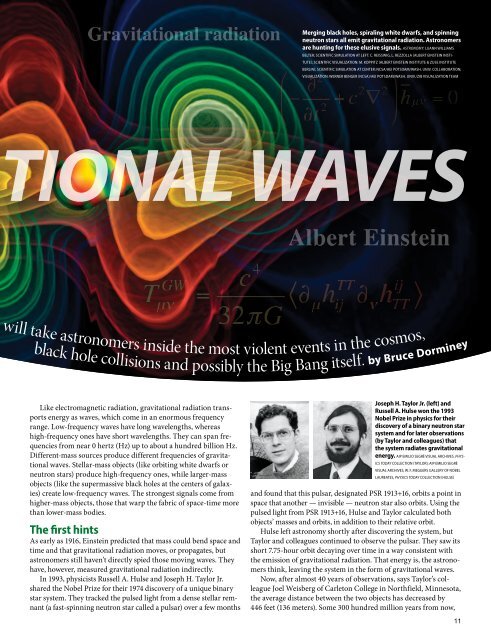GRAVITATIONAL WAVES
DIG-ASY-PRM_GravWavesFIN
DIG-ASY-PRM_GravWavesFIN
You also want an ePaper? Increase the reach of your titles
YUMPU automatically turns print PDFs into web optimized ePapers that Google loves.
Merging black holes, spiraling white dwarfs, and spinning<br />
neutron stars all emit gravitational radiation. Astronomers<br />
are hunting for these elusive signals. ASTRONOMY: LUANN WILLIAMS<br />
BELTER; SCIENTIFIC SIMULATION AT LEFT: C. REISSWIG, L. REZZOLLA (ALBERT EINSTEIN INSTI-<br />
TUTE); SCIENTIFIC VISUALIZATION: M. KOPPITZ (ALBERT EINSTEIN INSTITUTE & ZUSE INSTITUTE<br />
BERLIN); SCIENTIFIC SIMULATION AT CENTER: NCSA/AEI POTSDAM/WASH. UNIV. COLLABORATION;<br />
VISUALIZATION: WERNER BENGER (NCSA)/AEI POTSDAM/WASH. UNIV./ZIB VISUALIZATION TEAM<br />
TIONAL <strong>WAVES</strong><br />
will take astronomers inside the most violent events in the cosmos,<br />
black hole collisions and possibly the Big Bang itself. by Bruce Dorminey<br />
Like electromagnetic radiation, gravitational radiation transports<br />
energy as waves, which come in an enormous frequency<br />
range. Low-frequency waves have long wavelengths, whereas<br />
high-frequency ones have short wavelengths. They can span frequencies<br />
from near 0 hertz (Hz) up to about a hundred billion Hz.<br />
Different-mass sources produce different frequencies of gravitational<br />
waves. Stellar-mass objects (like orbiting white dwarfs or<br />
neutron stars) produce high-frequency ones, while larger-mass<br />
objects (like the supermassive black holes at the centers of galaxies)<br />
create low-frequency waves. The strongest signals come from<br />
higher-mass objects, those that warp the fabric of space-time more<br />
than lower-mass bodies.<br />
The first hints<br />
As early as 1916, Einstein predicted that mass could bend space and<br />
time and that gravitational radiation moves, or propagates, but<br />
astronomers still haven’t directly spied those moving waves. They<br />
have, however, measured gravitational radiation indirectly.<br />
In 1993, physicists Russell A. Hulse and Joseph H. Taylor Jr.<br />
shared the Nobel Prize for their 1974 discovery of a unique binary<br />
star system. They tracked the pulsed light from a dense stellar remnant<br />
(a fast-spinning neutron star called a pulsar) over a few months<br />
Joseph H. Taylor Jr. (left) and<br />
Russell A. Hulse won the 1993<br />
Nobel Prize in physics for their<br />
discovery of a binary neutron star<br />
system and for later observations<br />
(by Taylor and colleagues) that<br />
the system radiates gravitational<br />
energy. AIP EMILIO SEGRÈ VISUAL ARCHIVES, PHYS-<br />
ICS TODAY COLLECTION (TAYLOR); AIP EMILIO SEGRÈ<br />
VISUAL ARCHIVES, W. F. MEGGERS GALLERY OF NOBEL<br />
LAUREATES, PHYSICS TODAY COLLECTION (HULSE)<br />
and found that this pulsar, designated PSR 1913+16, orbits a point in<br />
space that another — invisible — neutron star also orbits. Using the<br />
pulsed light from PSR 1913+16, Hulse and Taylor calculated both<br />
objects’ masses and orbits, in addition to their relative orbit.<br />
Hulse left astronomy shortly after discovering the system, but<br />
Taylor and colleagues continued to observe the pulsar. They saw its<br />
short 7.75-hour orbit decaying over time in a way consistent with<br />
the emission of gravitational radiation. That energy is, the astronomers<br />
think, leaving the system in the form of gravitational waves.<br />
Now, after almost 40 years of observations, says Taylor’s colleague<br />
Joel Weisberg of Carleton College in Northfield, Minnesota,<br />
the average distance between the two objects has decreased by<br />
446 feet (136 meters). Some 300 hundred million years from now,<br />
11


